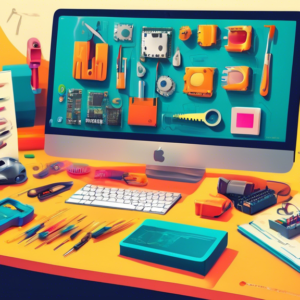Introduction: The Joys of DIY PC Building
Building your own PC might seem intimidating at first, like navigating a labyrinth of components and technical jargon. But fear not, intrepid beginner! This guide is here to demystify the process and empower you to construct a powerful, personalized machine. We’ll break down each step, explain the essential parts, and provide helpful tips to make your PC building experience smooth and rewarding.
Why Build Your Own PC?
Before diving into the nuts and bolts (or rather, screws and motherboards), let’s explore the compelling reasons why building your own PC trumps buying pre-built:
* **Customization:** Craft a PC tailored to your exact needs and preferences, whether it’s a gaming powerhouse, a sleek productivity machine, or a creative workstation.
* **Cost Savings:** Building your own PC often allows you to save money compared to buying a pre-built system with similar specs.
* **Higher Quality Components:** You have the freedom to choose higher-quality components, leading to better performance and longevity.
* **Sense of Accomplishment:** Completing your own PC build is incredibly rewarding, giving you a deeper understanding of how your computer works.
* **Upgradability:** Easily upgrade your PC over time by swapping out components, extending its lifespan and adapting to your evolving needs.
Gathering Your PC Building Arsenal
Before embarking on your PC building adventure, you’ll need to gather the necessary tools and components. Here’s a checklist to get you started:
Essential Tools:
* **Phillips head screwdriver with magnetic tip:** The workhorse of your toolkit, used for securing screws.
* **Anti-static wrist strap:** Protects components from static electricity discharge, which can cause damage.
* **Zip ties or Velcro straps:** Keep cables organized and manageable.
* **A well-lit workspace:** Adequate lighting is crucial for visibility during assembly.
* **A non-carpeted workspace:** Carpets can generate static electricity, posing a risk to components.
Core Components:
* **Central Processing Unit (CPU):** The brain of your computer, responsible for processing instructions.
* **Motherboard:** The central circuit board that connects all components.
* **Random Access Memory (RAM):** Short-term memory for running programs and multitasking.
* **Graphics Card (GPU):** Handles image processing and display output, crucial for gaming and graphics-intensive tasks.
* **Storage Drive (SSD or HDD):** Stores your operating system, files, and data.
* **Power Supply Unit (PSU):** Provides power to all components.
* **Computer Case:** Houses and protects all the components.
* **Operating System (OS):** The software that manages your computer’s hardware and resources (e.g., Windows, macOS, Linux).
Step-by-Step PC Building Guide
Now that you have your tools and components ready, it’s time to roll up your sleeves and dive into the assembly process:
1. Preparing the Case and Motherboard
* **Open the case:** Remove the side panels of your computer case to access the interior.
* **Install standoffs (if necessary):** Small metal spacers that raise the motherboard slightly to prevent electrical shorts.
* **Place the motherboard inside the case:** Align the ports on the motherboard with the corresponding openings on the case’s I/O panel.
* **Secure the motherboard:** Use screws to secure the motherboard to the standoffs.
2. Installing the CPU
* **Open the CPU socket lever on the motherboard.**
* **Align the CPU’s notch with the corresponding notch on the socket.**
* **Gently lower the CPU into the socket.**
* **Close the CPU socket lever.**
* **Install the CPU cooler:** Apply thermal paste (if not pre-applied) to the top of the CPU, then attach the cooler according to its instructions.
3. Installing RAM
* **Open the clips on the RAM slots.**
* **Align the notch on the RAM stick with the notch on the RAM slot.**
* **Push down on both ends of the RAM stick until it clicks into place.**
4. Installing the Graphics Card
* **Open the rear case slot closest to the motherboard’s PCIe x16 slot.**
* **Align the graphics card’s connector with the PCIe x16 slot.**
* **Push down on the graphics card until it clicks into place.**
5. Installing Storage Devices
* **Connect your storage devices (SSD/HDD) to the appropriate SATA ports on the motherboard.**
* **Secure the storage devices in their respective bays within the case.**
6. Connecting the Power Supply
* **Place the power supply in its bay and secure it with screws.**
* **Connect the appropriate power cables from the PSU to the motherboard, CPU, graphics card, and storage devices.**
7. Cable Management
* **Neatly route and bundle cables using zip ties or Velcro straps.**
* **Ensure cables are tucked away to improve airflow within the case.**
8. Initial Boot-Up and BIOS Setup
* **Connect your monitor, keyboard, and mouse to the rear I/O panel.**
* **Turn on the computer and enter the BIOS/UEFI settings.**
* **Configure boot order to prioritize your chosen storage device.**
* **Save and exit BIOS/UEFI settings.**
9. Installing the Operating System
* **Boot from your installation media (USB drive or DVD).**
* **Follow the on-screen prompts to install the operating system.**
10. Installing Drivers and Updates
* **Install drivers for your motherboard, graphics card, and other peripherals.**
* **Update your operating system and drivers to the latest versions.**
Tips for a Successful PC Build
* **Consult the manuals:** Refer to the manuals of your motherboard, CPU, and other components for detailed instructions.
* **Ground yourself:** Wear an anti-static wrist strap to prevent static electricity damage.
* **Take your time:** Avoid rushing the process to prevent mistakes.
* **Double-check connections:** Ensure all cables are securely connected.
* **Seek help if needed:** Don’t hesitate to ask for assistance from experienced builders or online forums.
Conclusion: Enjoy Your Custom-Built Masterpiece!
Congratulations on completing your first PC build! You’ve now joined the ranks of PC enthusiasts who enjoy the power and flexibility of a custom-built machine. With your newfound knowledge, you can continue to upgrade and personalize your PC to suit your evolving needs. Embrace the journey of exploration and discovery as you delve deeper into the world of PC building.
